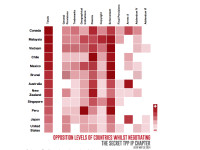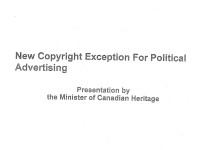This morning Wikileaks released an updated leaked version of the draft Trans Pacific Partnership intellectual property chapter. The latest leak dates from May 2014 (the previous leak was current to August 2013. I assessed it in posts here, here, here, here and here). The 77-page document provides a detailed look at the proposed chapter, complete with country positions on each issue. While a comprehensive assessment of the chapter will take some time, the immediate takeaway is that the U.S. remains fairly isolated in its efforts to overhaul patent and copyright law around the world with Canada emerging as the leading opponent of its demands.
Latest Posts
Government Opens Door to Major Changes to Digital Privacy Bill
While it was overshadowed by the headlines over potential copyright reform, Peter Van Loan, the government’s House leader, disclosed last week that the government is planning to send Bill S-4, the Digital Privacy Act, to the Industry Committee for review prior to second reading. The bill, which has proven controversial due to a provision that expands the possibility of voluntary disclosure of subscriber information and relatively weak security breach disclosure rules, will be open to more significant reforms that previously thought possible (my remarks before the Senate committee can be found here). Under Parliamentary rules, referring a bill before second reading allows the committee to alter the scope of the bill.
Broadcaster Copyright Misuse and Collusion?: Why Criticism Over the Government’s Political Ad Copyright Exception May Be Pointed in the Wrong Direction
The Canadian Thanksgiving weekend featured escalating rhetoric over the government’s proposed copyright exception for political advertising with claims of fascism, censorship, expropriation, and more. The commentary bears almost no relationship to reality. The truth is that the government and the broadcasters both agree that the current law already permits use without authorization. For all the claims of “theft”, the copyright owner (broadcasters) and user (political parties) both agree that the works can be used without further permission or payment. As Ariel Katz points out this morning, the bigger issue may well be whether Canada’s broadcasters violated the Competition Act by conspiring to not air perfectly lawful political advertisements.
I wrote about the controversy in my weekly technology law column (Toronto Star version, homepage version), but the debate can be boiled down to three issues.
The Government’s Political Advertising Copyright Exception: Fine Print Shows Proposal Privileges Politicians’ Speech Rights Over the Public
Last night I posted on reports that the Canadian government is considering a new copyright exception for political advertising. While many have been harshly critical of the plans, I’ve noted that political speech is critically important and that copyright law should not be used to stifle it. My post argues that the law may already cover some of the uses and that if changes are needed, a better approach would be to adopt a fair use provision in Canada.
I have now obtained a copy of the document that was presented by the Minister of Canadian Heritage. The document is obviously consistent with the media reports, but provides significantly more detail and raises several additional questions and concerns.
Why Isn’t Fair Dealing Enough?: Government Considering Copyright Exception to Cover Political Advertising
Reports from CTV and the Globe and Mail indicate that the government is planning to introduce a new copyright exception for political advertising. The reports suggest that the exception would permit the use of news content in political advertising without authorization provided that it meets three conditions:
News content would have to meet three criteria for this exemption, the cabinet memo says. It would have to be published or made available through TV broadcasts or platforms such as YouTube. It would have to be obtained from a news source such as a news program or newspaper or periodical. And it would have to feature a political actor operating in that person’s capacity as a politician, or relate to a political issue.
While the reports sparked an immediate reaction claiming the government is legalizing theft, my view is that copyright law should not be used to stifle legitimate speech. Political speech – even noxious attack ads – surely qualifies as important speech that merits protection (see this CDT analysis for similar concerns in the US). I am not a fan of attack ads, but attempts to use copyright to claim absolute rights over the use of a portion of a video clip is surely counter to basic principles of fair dealing (in Canada) or fair use.











